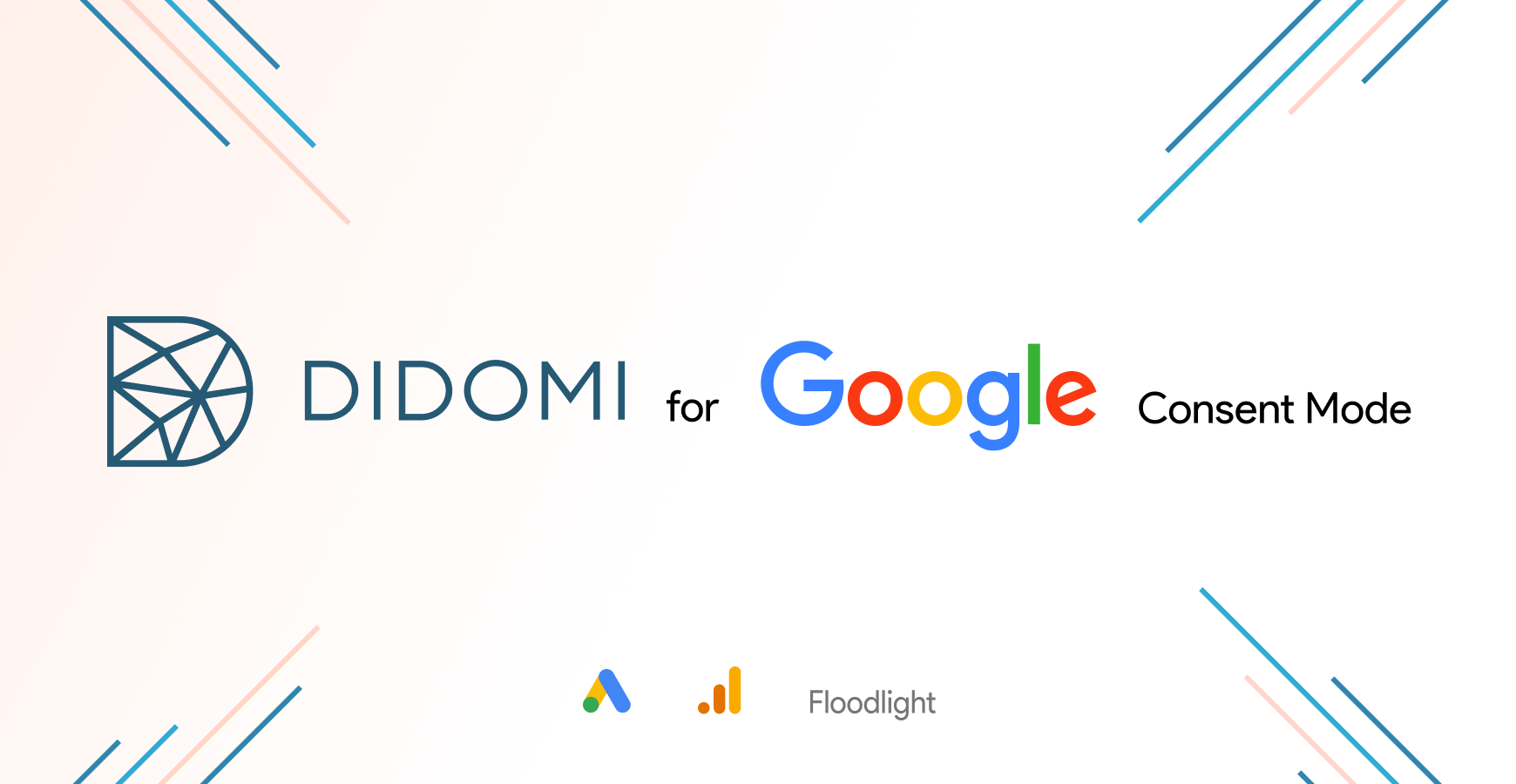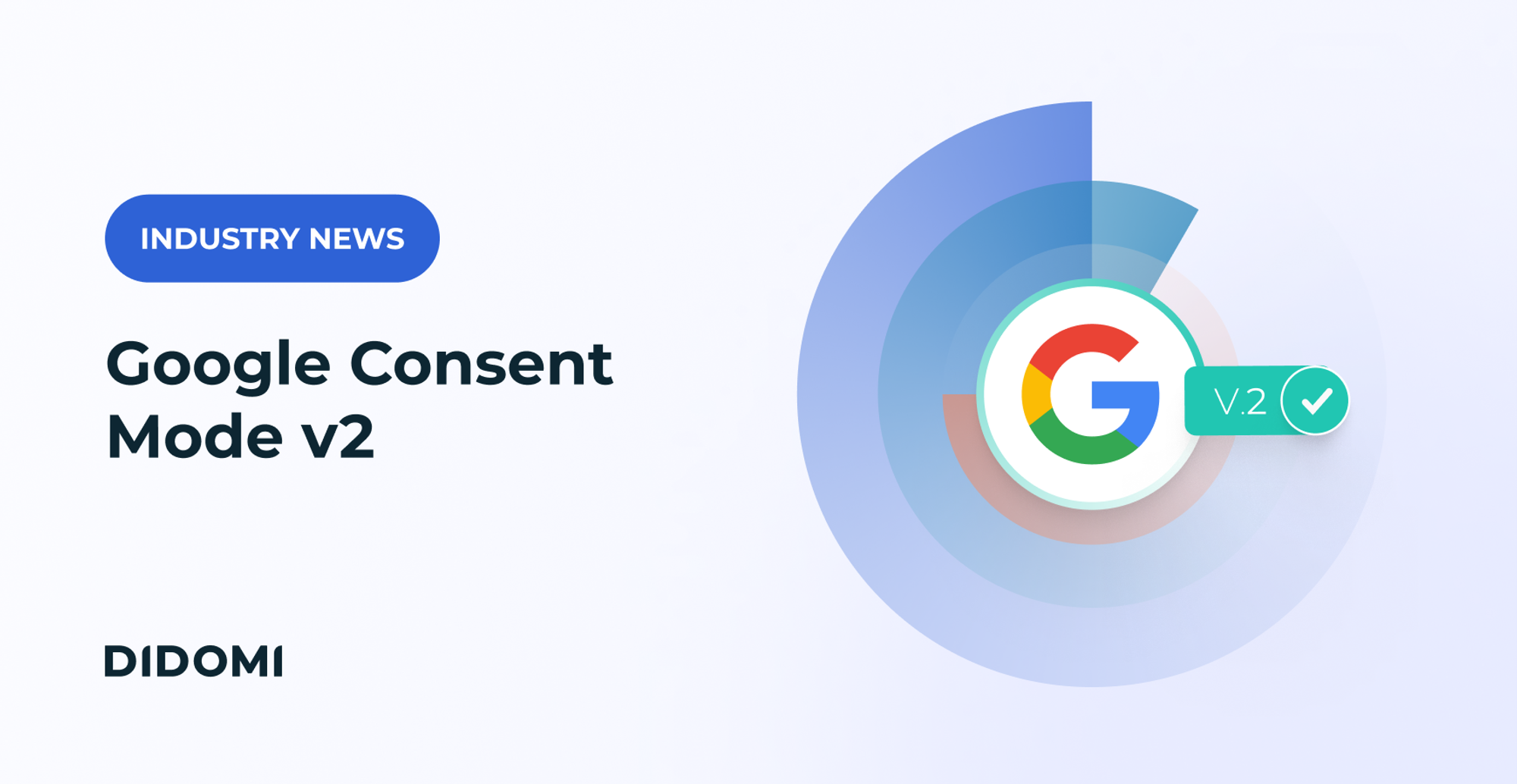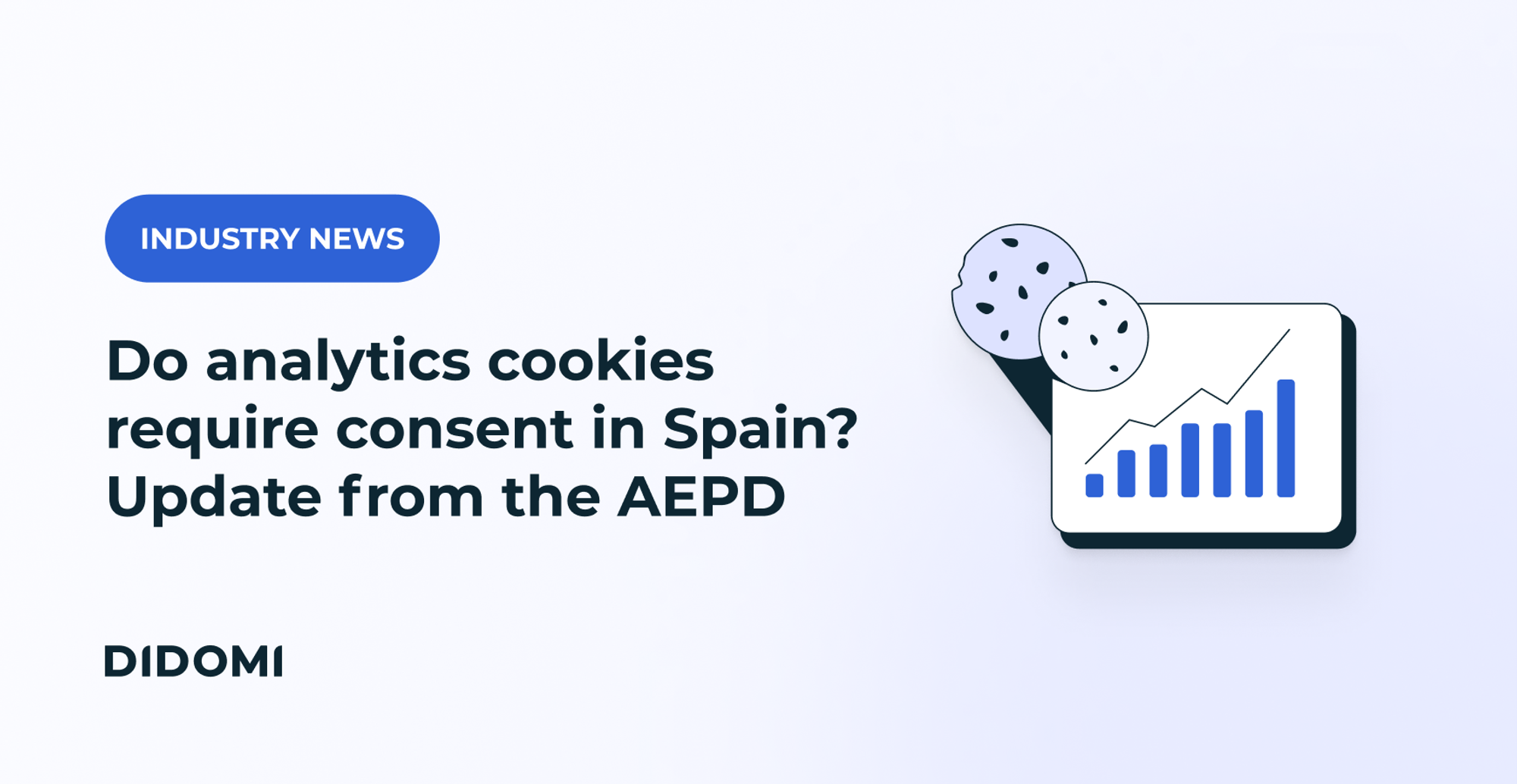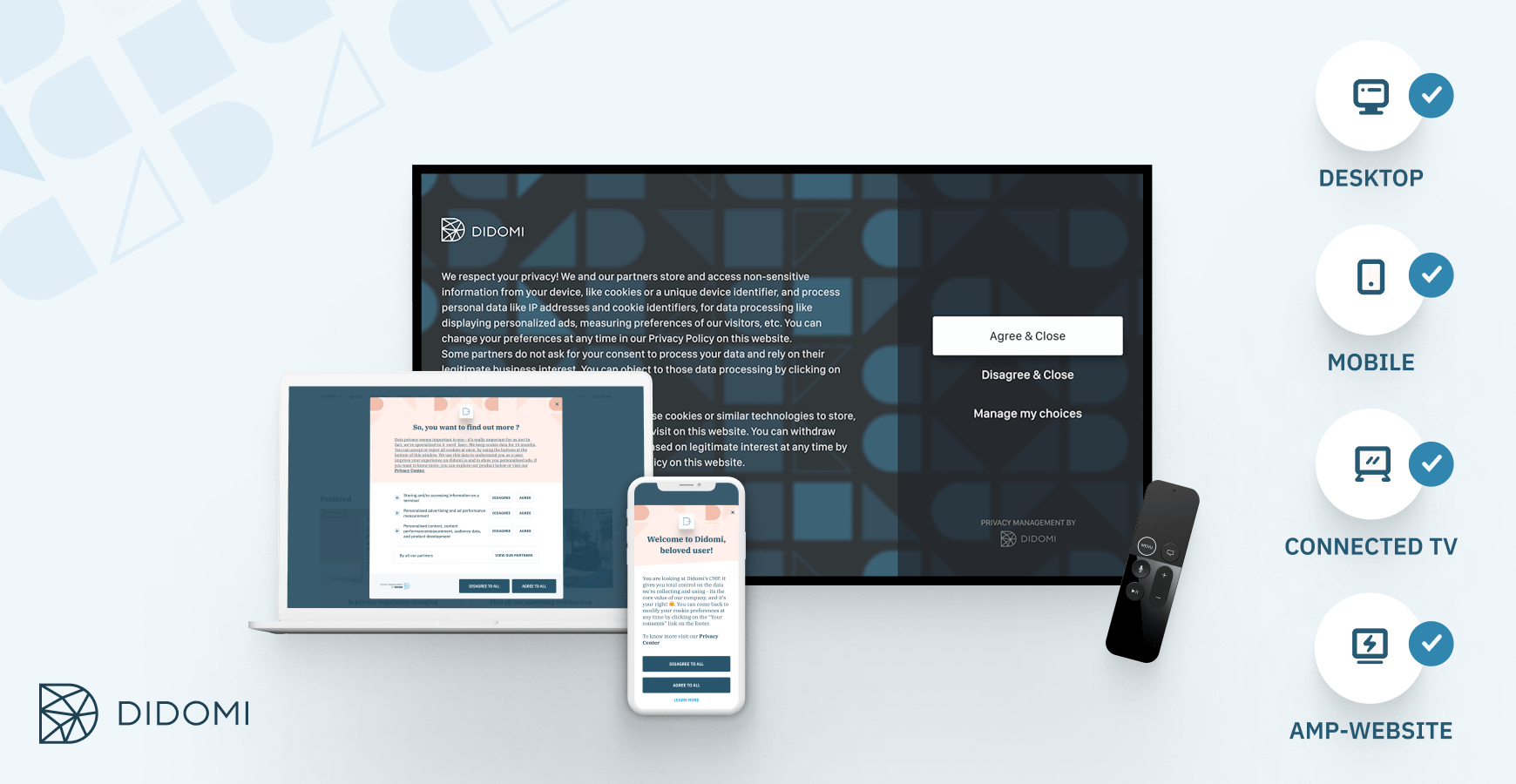Personalizing user experience and understanding user behavior allows companies to measure online campaigns and monetize ad revenue effectively.
Thanks to the Didomi Google Consent Mode integration, you can achieve greater insights into your conversion data for advertising and analytics purposes while respecting user choice when using Google Ads, Google Analytics, Floodlight, or Conversion Linker. Continue reading to find out how.
|
Important note: As of 2023, Google has introduced its Consent Mode V2, with updated requirements for every organization with users in the European Economic Area using Google advertising and measurement products.
|
Summary :
-
How can you implement Google Consent Mode with the Didomi CMP?
-
Why do you still need a Consent Management Platform to be GDPR compliant?
What is Google Consent Mode?
Many companies wish to provide a personalized online experience, to understand where people are converting to effectively measure online campaigns and monetize ad revenue. However, this is becoming increasingly challenging in an ever-changing ecosystem.
Put simply, we’re entering a new world of conversion measurement, once in which user consents take pride of place.
The phasing out of third-party cookies, platform changes such as Apple ITP and Firefox ETP, toughening data collection regulation from data protection authorities around the globe… The reasons behind this changing ecosystem are numerous. However, they all have the same root cause: the need for more user data privacy and personal data protection.
There won’t be a one size fits all solution to replace cookies. But that does not mean that there is not a solution in terms of data collection and data analytics. Rather, we need to rely on new types of privacy safe measurement solutions to give us back what cookies used to give us.
This is why Google as a company is moving towards aggregated forms of measurement that are more privacy safe, prioritizing the user’s explicit consent. This is why Google is creating a portfolio of privacy-centric solutions to help advertisers preserve their conversion measurement. This is why Google Consent Mode was built, and this is why it matters.
For advertisers, Google Consent Mode serves as a link between data privacy regulations and digital advertising by adjusting the behavior of Google tags to each user’s consent status.
Many companies wish to provide a personalized online experience and understand where people are converting, in order to effectively measure online campaigns and monetize ad revenue.
However, data-protection authorities in Europe require many businesses to obtain consent from users on their digital properties for activities related to advertising and/or analytics—impacting advertisers’ understanding of user behaviour.
Google Consent Mode is an API developed to offer more versatility in how companies can use Google products together with their cookie consent notice.
What is the aim of the Consent Mode API? Privacy safe measurement.
Ultimately, the goal is to create a win-win situation for users and advertisers. Google introduced Consent Mode so that users can have the data rights they deserve, but advertisers are still able to measure conversions.
How does Google Consent Mode work?
So, Google Consent Mode (GCM) works to allow advertisers to indicate the cookie consent state of a user, and allows Google to model for gaps in conversions.
Thanks to Google Consent Mode API, advertisers can measure conversions while respecting user consent choices. On average, Consent Mode recovers more than 70% of ad-click-to-conversion journeys lost due to user cookie consent choices.
Google Consent Mode is established on two main pillars:
-
User Privacy: Tags behave in a consent-aware way, respecting user choices based on ad_storage and analytics_storage.
-
Modelling: Google is able to use those consent signals and model for lost conversions due to consent changes.
To be eligible for GCM, an advertiser needs to have:
-
Global site tag or Google Tag Manager implemented sitewide (Google Tag Manager unlocks compatibility with advanced measurement solutions, find out more about the Didomi X Google Tag Manager integration here);
-
A presence in the EEA + UK region or in regions with relevant regulations;
-
A consent banner either already in place or planned to be put in place as part of the GCM activation.
With Google Consent Mode, your website’s analytics and marketing can run seamlessly based specifically on user consents.
So, there are two different possibilities.
Option 1 - The user gives their consent
If the user provides explicit consent, Google tags and measurement tools work as normal. Conversions are reported and ads cookies are used, allowing the company to better understand user behavior.
Option 2 - The user does not provide consent
If a user does not provide consent, the relevant Google tags and tag settings will adjust accordingly. Google Analytics will not read or write ads cookies or analytics cookies, as consent has not been given. Optional features that rely on Google signals will be automatically disabled. Google tags behave based on the consent status.
This way, publishers can obtain insights about campaign conversions and other data, whilst always respecting user consent choices for advertising cookies and analytics cookies. This is a win-win situation that will allow publishers to optimize and improve ad monetization.
How can you implement Google Consent Mode with the Didomi CMP?
The Didomi Consent Management Platform perfectly integrates with Google Consent Mode to provide one all-encompassing platform where users can make their consent choices, and publishers can manage that consent.
It’s a seamless process :
-
Users make their consent choices on the Didomi consent banner as normal.
-
The Didomi CMP indicates to Google via Google Consent Mode whether consent has been granted for Analytics and advertising cookies.
-
Google's tags will dynamically adapt, only utilizing tools for the specified purposes when consent has been given by the user.
-
When consent for ad storage or analytics storage is denied, the associated Google measurement functions deployed via global site tags (gtag.js) or Google Tag Manager will adjust the behavior of the Google tags accordingly. (Find out more about Google Tag Manager and Google tags in our article here)
All Didomi customers can enable Google Consent Mode via the integrations vendors property in the Didomi Console.
How can Didomi clients integrate with GCM?
At Didomi, we have created two ways to integrate with GCM, one that is more targeted to developers, and the other that is more user-friendly.
-
The developer-oriented option: This option is often used for testing. We use a Didomi config object in which we pass the parameter ecm with a flag enable set to true. Given we’ve already integrated the SDK, that’s it!
-
The user-friendly option: Our non-developer option functions in the Didomi Console. All Didomi customers can enable Google Consent Mode via the integrations vendor property in the Didomi Console, as seen in the image below.
Thanks to the Didomi Google Consent Mode integration, Didomi clients can achieve greater insights into their conversion data while respecting user choice via their consent status.
Webinar Didomi X Google
We asked Google, with whom we work closely, if they wanted to participate in a joint webinar to discuss GCM, its impact on the industry, and the Didomi X GCM integration. They were eager to do so!
Catch the replay below. For a live demo of the Didomi X Google Consent Mode integration, skip to 17:30 in the replay, where Didomi software developer Edgardo Rodriguez walks us through step by step.
Which Google services work with Consent Mode?
So, which Google services work alongside Consent Mode? The following services currently support Consent Mode:
-
Google Analytics
-
Google Ads (Google Ads Conversion Tracking and Remarketing)
-
Floodlight
-
Conversion Linker
GCM X Google Analytics
To dive a little deeper, let’s take Google Analytics as an example. Google Analytics is a tool that enables the monitoring and analysis of user behavior on a website or app through the collection of client-side data.
Google Consent Mode works with Google Analytics to ensure that user consent choice in terms of ads/marketing cookies is respected. If the user does not give their consent, Google Analytics will not read or write ads cookies. Therefore, processes such as retargeting that rely on Google signals will be deactivated.
GCM X Google Ads (Google Ads Conversion Tracking and Remarketing)
With Consent Mode your website will still be able to record and measure conversions from Google Ads, Campaign Manager, Display & Video 360, and Search Ads 360. It will just do so in a way that is more privacy-centric, based on the user's consent.
The tag “ad_storage” controls cookie behavior for advertising purposes, including conversion measurement.
So, if someone visits a website and makes a conversion, accepting cookies (including marketing cookies) in the cookie consent notice, reporting will continue as normal. If the user clicks on “I reject” on the cookie banner, the ad_storage google tags will adjust and not read/write any marketing cookies. The website owner will still receive data on conversions, but at a more aggregated level.
Don’t hesitate to reach out for more information on which Google services support consent mode, and how these work with the Didomi Consent Management Platform.
Why do you still need a Consent Management Platform to be GDPR compliant?
It’s important to note that Google Consent Mode does not replace the need for a consent solution such as a Consent Management Platform.
It remains the website operator’s responsibility to gather consent and store it in a GDPR compliant way, using a valid consent solution. Compliant use of Google Consent Mode therefore requires fully functioning consent management technology to collect and store user consent choices, such as the bespoke Didomi Consent Management Platform.
To think of it in more visual terms, Google Consent Mode effectively acts as the bridge between the website’s Consent Management Platform (consent solution) and Google, allowing Google services to act in a way according to user consent, without requiring Google to actually have access directly to any personal data.
What does this mean for advertisers and users?
Ultimately, this is a win-win solution for advertisers and users.
Users have the data rights they deserve
From a user point of view, they have the data rights they deserve. They have more control over their personal data. They can choose whether to opt-in or opt-out, and are in charge of the user data they choose to share.
Users are faced with an easy and clear choice on the Didomi consent banner: they simply have to click on either “Accept” or “Reject”. The CMP then automatically transfers the consent status to Google via Google Consent Mode - all the user has to do is sit back and relax, safe in the knowledge that their data is not being exploited! Users are in the driving seat of their personal data.
Advertisers can continue to measure conversions
From an advertiser point of view, this integration also represents the best of both worlds.
Google Consent Mode bridges the gap between data protection and digital advertisement by making sure that your website’s analytics and marketing can run seamlessly based on each specific user’s consent choice.
Advertisers are still able to obtain invaluable insights and statistics about campaign conversions and other data. They are able to optimize and improve ad monetization, without undermining the data choices of their users.
This is a big step forward for the industry, a move towards putting user choice at the heart of data collection and usage, without sabotaging publisher monetisation efforts.
With Google Consent Mode, data privacy laws do not spell out the end of publisher monetization, just a move towards user-centricity and explicit user consent. Didomi is proud to have integrated Google Consent Mode, in the aim of helping companies to place customer consent at the core of their strategy when using Google Analytics, Google Ads or Google Tag Manager.
For more information, do not hesitate to contact us.








